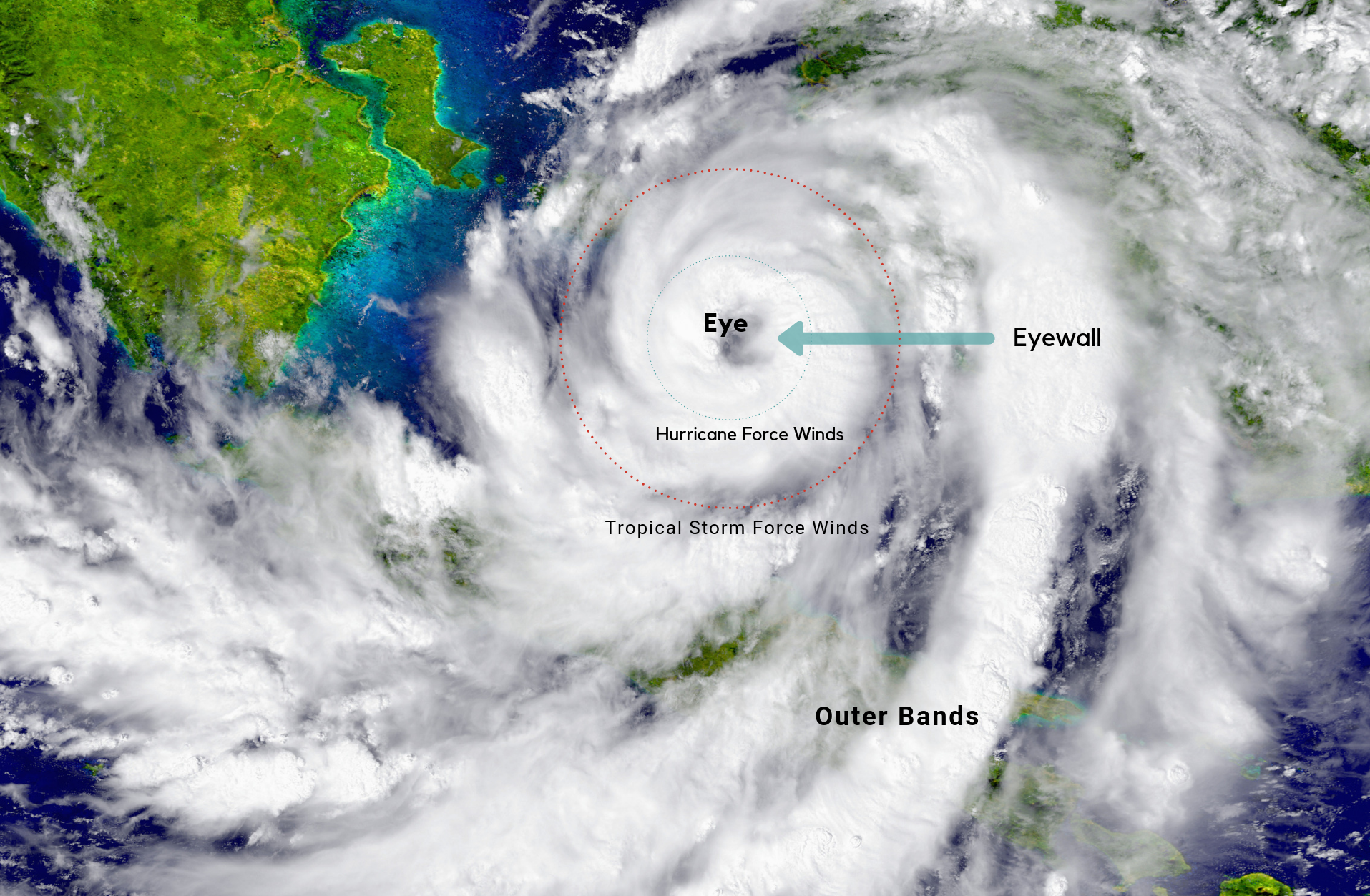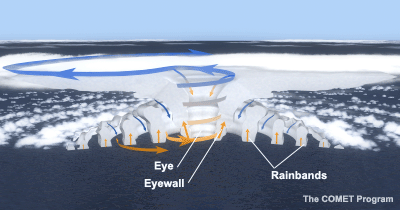Describe the Different Parts of a Hurricane
There are generally no. The eye is surrounded by the eyewall where winds are strongest.
Heavy rain and storm surge from a hurricane can cause flooding.

. Devastating damage will occur. These surges can pummel the area engulfing any object its path. Hurricane winds blow in a counterclockwise spiral around the calm roughly circular center called the eye.
Hurricanes have three main parts the calm eye in the center the eyewall where the winds and rains are the strongest and the rain bands which spin out from the center and give the storm its size. They also predict how strong it will get. Those with maximum sustained winds of 39 mph or higher are called tropical.
Outflow is the high-level clouds moving outward from the hurricane. Feeder bands are the areas of heavy rain and gusty winds fed by the warm ocean. Storms that form north of the equator spin counterclockwise.
The hurricane winds can cause sea levels to rapidly rise as the hurricane makes landfall. Hurricanes form over warm ocean waters. Parts of a hurricane include.
When wind speeds within such a storm reach 74 mph its classified as a hurricane. Rainbands - Hurricanes have large. All three of these terms describe the same atmospheric processes and the same types of storms.
Because hurricanes rotate circularly the center is relatively calm in comparison which is called the eye of the storm and may be as large as 20-30 miles wide or 32-48 km wide. These rotating winds lead to the development of the characteristic eye of the hurricane the calm clear center of the storm. Category 3 hurricane.
Typical hurricanes are about 300 miles wide although they can vary considerably in size. If the storm continues to feed off. Sustained winds of of 156 and more.
Sometimes they strike land. The most dramatic examples of low pressure systems leading to storms and rain are hurricanes cyclones and typhoons. Sustained winds of 131-155.
The Spiral Rain Bands-. Sustained winds of 111-130. The strongest winds of the hurricane are in the eye wall.
Up in the clouds water condenses and forms droplets releasing even more heat to power the storm. Strongest winds of hurricane in a band surrounding the eye. If certain conditions in the atmosphere are present the gathering of individual clouds will begin to organize into a single storm.
The eye is an area of very low air pressure. Parts of a Hurricane Eye - At the center of the hurricane is the eye. This wall of water is called a storm surge.
The Eye- innermost portion of the storm. The storms lowest pressure reading are found here. When a hurricane reaches land it pushes a wall of ocean water ashore.
Hurricanes begin life as a small gathering of unorganized storms which gain energy from the heat of the ocean water. As the warmed moist air rises and cools off the water in the air forms clouds. Spiraling rainbands eye eye wall.
The three parts of the hurricane are. Sustained winds of 96-110. The Eye Wall- dense wall of thunderstorms directly surrounding the eye.
Hurricanes are intense storms that originate in the Tropics. Meteorologists use the Saffir-Simpson Hurricane Wind Scale to classify hurricanes into categories one to five. The eyewall surrounding the eye is composed of dense clouds that.
Tropical cyclones are classified by their maximum wind speed. In the eye which is roughly 20 to 30 miles wide it is relatively calm and there is little or no rain. Hurricane winds have the power to uproot trees and debris turning them into high-speed projectiles.
Surrounding the eye is the eyewall a wall of thunderclouds. In a Category 3 hurricane winds range from 111 to 129 mph. A hurricane consists of five main parts.
There is a high risk of injury or death to people livestock and pets from flying. Storm surges are the deadliest result of hurricanes. A tropical cyclone is a rotating low-pressure weather system that has organized thunderstorms but no fronts a boundary separating two air masses of different densities.
Its just that different terminology is used in different parts of the world. Eye wall - Around the outside of the eye is a wall made up of very heavy clouds. Tropical cyclones with maximum sustained surface winds of less than 39 miles per hour mph are called tropical depressions.
Once a hurricane forms weather forecasters predict its path. Outflow feeder bands eyewall eye and the storm surge. Sustained winds of 74-95.
Parts of a Hurricane Hurricanes have three parts. Other definitions for Hurricanes. In the Atlantic and Northeast Pacific the storms are.
The whole system of clouds and wind spins and grows fed by the oceans heat and water evaporating from the surface. The air then rises and cools forming clouds and thunderstorms. The eye at a hurricanes center is a relatively calm clear area approximately 20-40 miles across.
The wall of intense thunderstorms surrounding the eye. This region can be as large as 30 miles in diameter and the skies are often clear and winds are light. This is the most dangerous part of the.
The eye is the warmest part of the storm. Hurricanes can cause flooding injury deaths tornados extremly severe thunder. As the warm air continues to rise the surrounding air swirls in to take its place.
The eye the eyewall and rain bands.




0 Response to "Describe the Different Parts of a Hurricane"
Post a Comment